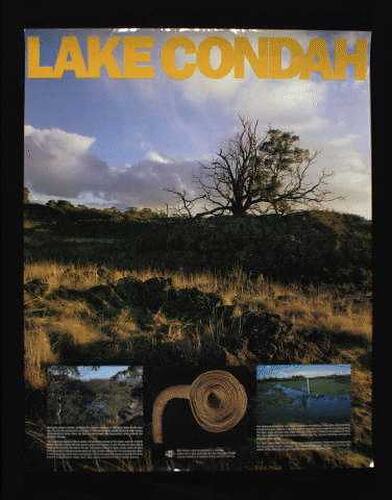Summary
Poster promoting the role and work of the state government organisation, The Victorian Archaeological Survey (VAS) and The Gundidj-Kerupjmara (Mara) people, in protecting cultural heritage sites at Lake Condah. Printed text reads 'Aboriginal people probably witnessed the volcanic eruptions at Mt. Eccles some 27,000 years ago. The lava flow advanced for more than 50 kilometres, filling valleys, blocking water courses and forming the Stony Rises, the bed of Lake Condah and deep impressions which evolved into food rich swamps. The Gundidj-Kerupjmara (Mara) people, the traditional owners of the region, used the volcanic stone to build complex fish trap systems around the margins of Lake Condah, and along Darlot Creek which connects the Lake to the sea. The systems consist of races, canals, walls and weirs which operated in sequence as the waters of Condah rose and fell. Fish and eels were taken in nets or baskets, woven from local grasses, which were placed at sluices in canals and at the centre of V-shaped weirs. Today, many Mara women continue the craft of basket weaving.'
Originally known as the Archaeological and Aboriginal Relics Office, VAS conducted surveys and excavations of historical, maritime and Aboriginal archaeological sites, including rock art sites, across the state. VAS compiled lists of known archaeological sites and produced numerous reports on Victoria's archaeological history, site specific surveys as well as technical reports and guides. In the early 1990s, Aboriginal Affairs Victoria took over the management of Aboriginal archaeological sites.
Physical Description
Colour ink on paper. Title: 'Lake Condah' printed in yellow. Features a photograph a tree amongst remnants of stone foundations. Three smaller photographs horizontal at the bottom of the page. White printed text.
More Information
-
Object/Medium
Poster
-
Locality
-
Number of Sheets
1
-
Number of Pages
1
-
Overall Dimensions
595 mm (Width), 755 mm (Height)
-
Organisation Named
-
Keywords
-
Type of item
-
Discipline
-
Category
-
Collecting Areas
Ethnohistory, Australian Indigenous Identity and Contemporary Life
Title
Lake Condah
